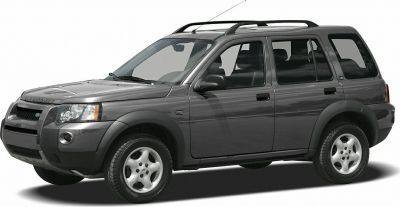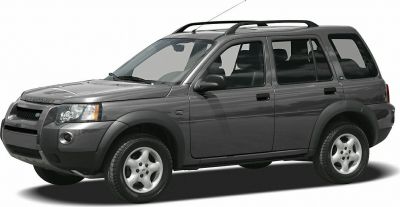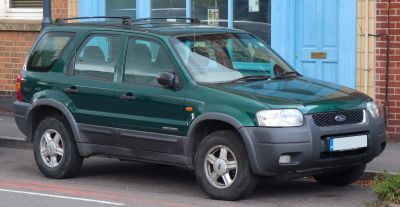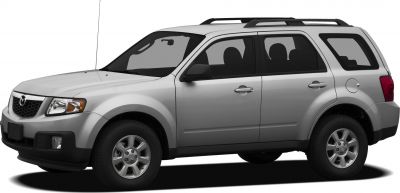 2001 Ford Escape I Dimensions, Size & Specs
2001 Ford Escape I Dimensions, Size & SpecsMeasurements of the 2001 Ford Escape I, engineered for optimal performance and comfort
| Dimensions | |
|---|---|
| Length: | 4394-4442 mm173.0-174.9 in14.4-14.6 ft |
| Width: | 1781 mm70.1 in5.8 ft |
| Height: | 1702-1775 mm67.0-69.9 in5.6-5.8 ft |
| Ground Clearance: | 213 mm8.4 in0.7 ft |
| Trunk Capacity: | 782-934 liter27.6-33.0 cu ft |
| Trunk Capacity (Max): | 1835-1855 liter64.8-65.5 cu ft |
| Weight Specifications | |
| Curb Weight: | 1420-1745 kg3131-3847 lbs |
| Maximal permitted Weight: | 1872-2054 kg4127-4528 lbs |
| Tire Specifications | |
| Rims Size: |
|
| Tire Sizes: |
|
The Ford Escape I, produced from 2000 to 2007, is a compact SUV that marked Ford's strong entry into the competitive SUV market. Designed to balance urban practicality with off-road capability, this generation of the Escape features a length ranging from 4394 mm to 4442 mm (173 to 175 inches), a width of approximately 1780 mm to 1781 mm (70.1 to 70.2 inches), and a height varying between 1702 mm and 1775 mm (67 to 69.9 inches). These dimensions position it comfortably within the compact SUV segment, appealing to drivers seeking a versatile vehicle. The curb weight of the Escape I ranges from 1420 kg to 1745 kg (3130 to 3850 lbs), depending on equipment and drivetrain variations, while the maximum weight capacity is between 1872 kg and 2054 kg (4129 to 4529 lbs), ensuring a robust load-carrying ability. Specific to utility, the Escape I offers a generous luggage capacity from 782 liters to 934 liters (27.6 to 33 cubic feet) with rear seats upright, which expands impressively to between 1835 liters and 1855 liters (64.8 to 65.5 cubic feet) when the rear seats are folded down, making it well-suited for family trips or transporting bulky items. Riders will also appreciate the 213 mm (8.4 inches) ground clearance, supporting moderate off-road adventures and better handling on rough terrain. The standard rim size is 15 inches, with tire options typically sized 225/70 R15 or 235/70 R16, balancing ride comfort with grip and stability. Overall, the first-generation Ford Escape is a well-rounded compact SUV offering dependable performance and practical space, ideal for diverse driving needs during its production years from 2000 to 2007.
Discover the standout features that make the 2001 Ford Escape I a leader in its class
Have a question? Please check our knowledgebase first.
The Ford Escape I (2001), produced between 2000 and 2007, measures between 4394 mm and 4442 mm (173 to 175 inches) in length. These dimensions place it on the compact end of the SUV spectrum during its production period, making it a practical option for city driving and moderate off-road adventures. Compared to other compact SUVs from the early 2000s, the Escape’s length offered a good balance between interior space and maneuverability. Its length was comparable to contemporaries such as the Honda CR-V and Toyota RAV4, providing adequate cabin space without being overly large. This length allowed the Escape to comfortably fit into standard parking spaces and urban environments, a key consideration for buyers seeking an SUV with daily usability.
The Ford Escape I features a width ranging from 1780 mm to 1781 mm (approximately 70.1 to 70.2 inches). This width is typical for compact SUVs of its era and generally allows for sufficient interior space while maintaining ease of maneuverability in urban settings. The relatively moderate width ensures the vehicle can navigate narrow streets and parking lots without much difficulty. Additionally, this width dimension supports stable handling and contributes to the vehicle’s comfortable cabin width for passengers. In practical terms, this makes the Escape I suitable for drivers who need an SUV that is spacious but not cumbersome in tight parking garages and congested areas.
The height of the Ford Escape I ranges from 1702 mm to 1775 mm (approximately 67 to 69.9 inches). This relatively tall stature compared to sedans and hatchbacks is typical for SUVs and contributes to increased headroom inside the vehicle. The Escape I also benefits from a ground clearance (ride height) of 213 mm (8.4 inches), which is quite favorable for a compact SUV. This ride height enables the vehicle to handle light off-road conditions, such as gravel roads or uneven terrain, with relative ease. It strikes a balance between everyday urban driving comfort and occasional adventurous trips, supporting the Escape’s reputation as a versatile and practical SUV for a variety of driving environments.
The Ford Escape I has a curb weight ranging from 1420 kg to 1745 kg (approximately 3130 to 3847 lbs), with a maximum weight between 1872 kg and 2054 kg (4130 to 4528 lbs). These weights reflect variations due to trim levels, drivetrain options, and additional equipment. The relatively light curb weight for an SUV improves both fuel efficiency and vehicle agility, making it easier to handle in urban traffic and during off-road excursions. Lighter weight contributes to better acceleration and braking response but is balanced by the rugged design elements typical in an SUV. The maximum weight includes passengers and cargo, so when fully loaded, the Escape maintains stability without compromising safety or performance under typical driving conditions.
The Ford Escape I provides a luggage capacity of between 782 and 934 liters (about 27.6 to 33 cubic feet) with rear seats upright, which is substantial for a compact SUV and suitable for daily needs or weekend trips. When the rear seats are folded down, the available luggage space expands dramatically to between 1835 and 1855 liters (approximately 64.7 to 65.5 cubic feet). This increase allows the Escape to accommodate larger or bulky items such as sports equipment, furniture, or a significant amount of luggage for extended travel. The flexibility of expanding cargo space is one of the Escape's strong points, facilitating versatility for families and active lifestyles.
The Ford Escape I typically came with 15-inch rims, paired with tire sizes of 225/70 R15 or 235/70 R16. The rim and tire combination played a crucial role in balancing ride comfort, road grip, and handling performance. The 225/70 R15 tires are slightly narrower, offering potentially better fuel economy and a more comfortable ride due to larger sidewalls absorbing surface imperfections. Meanwhile, the 235/70 R16 tires provide a wider contact patch with the road, which can enhance traction, especially in adverse conditions such as wet or off-road surfaces. These tire sizes ensure that the Escape I delivers a stable, controlled ride whether commuting in the city or engaging in light off-road adventures.
Yes, the Ford Escape I fits comfortably into a standard residential garage. Standard garage dimensions often range around 2400 mm (8 feet) in width and 4800 mm (16 feet) in depth. With a width of about 1780 mm (70 inches) and a length between 4394 mm and 4442 mm (173 to 175 inches), the Escape I leaves ample space on all sides when parked inside a typical garage. Additionally, its height of up to 1775 mm (approximately 69.9 inches) easily clears most garage door heights, which usually start at around 2032 mm (80 inches). This means owners can expect the Ford Escape I to comfortably fit within their home garages without special accommodations or modifications.
The Ford Escape I was introduced as Ford's first compact SUV influenced by Japanese-American collaboration (Mazda and Ford), effectively replacing the Ford Maverick in the compact SUV segment. Compared to the Maverick, the Escape offered a more modern design, improved interior space, and better safety features. In terms of size, the Escape I was more compact and had better ground clearance, supporting moderate off-road use. When compared to similar SUVs from the same era such as the Honda CR-V and Toyota RAV4, the Escape was broadly competitive, featuring a slightly taller stance and comparable cargo capacity. It distinguished itself through its rugged styling and available all-wheel drive options, appealing to buyers seeking a versatile, practical vehicle.
The Ford Escape II, which followed the Escape I, introduced several dimensional and design changes. The second generation generally grew slightly in length and width, enhancing interior space and comfort for passengers. While the Escape I ranged from 4394 mm to 4442 mm in length and about 1780 mm in width, the Escape II typically offered increases of several centimeters in length and width, improving overall roominess. Additionally, the Escape II featured updated suspension, improved ride quality, and more advanced technology and safety features. Ground clearance remained competitive, preserving off-road capability. These changes made the Escape II feel more refined and better suited for family use and longer drives without sacrificing the versatility that defined the first generation.
The Ford Escape I was competitive among compact SUVs of the early 2000s, offering balanced fuel efficiency, respectable performance, and practical interior space. Fuel economy varied depending on engine choice and drivetrain, with the Escape generally achieving moderate consumption relative to its all-wheel drive and SUV capabilities—often competitive with rivals like the Honda CR-V and Toyota RAV4. Performance was adequate for daily driving and light off-roading, supported by the vehicle's moderate curb weight and ground clearance. Interior space was well-utilized, with flexible cargo areas and comfortable seating. Its blend of features, size, and capabilities made it appealing for buyers needing a versatile vehicle able to handle city, suburban, and light off-road driving demands effectively.
Discover similar sized cars.

| Production: | 1998-2006 |
|---|---|
| Model Year: | 1998 |
| Length: | 4368-4445 mm172.0-175.0 in |
| Width: | 1809 mm71.2 in |
| Height: | 1708-1760 mm67.2-69.3 in |

| Production: | 1998-2006 |
|---|---|
| Model Year: | 1998 |
| Length: | 4368-4433 mm172.0-174.5 in |
| Width: | 1809 mm71.2 in |
| Height: | 1708-1760 mm67.2-69.3 in |

| Production: | 2000-2007 |
|---|---|
| Model Year: | 2000 |
| Length: | 4394-4441 mm173.0-174.8 in |
| Width: | 1781-1825 mm70.1-71.9 in |
| Height: | 1722-1762 mm67.8-69.4 in |

| Production: | 2000-2011 |
|---|---|
| Model Year: | 2001 |
| Length: | 4395 mm173.0 in |
| Width: | 1800-1825 mm70.9-71.9 in |
| Height: | 1710-1765 mm67.3-69.5 in |
